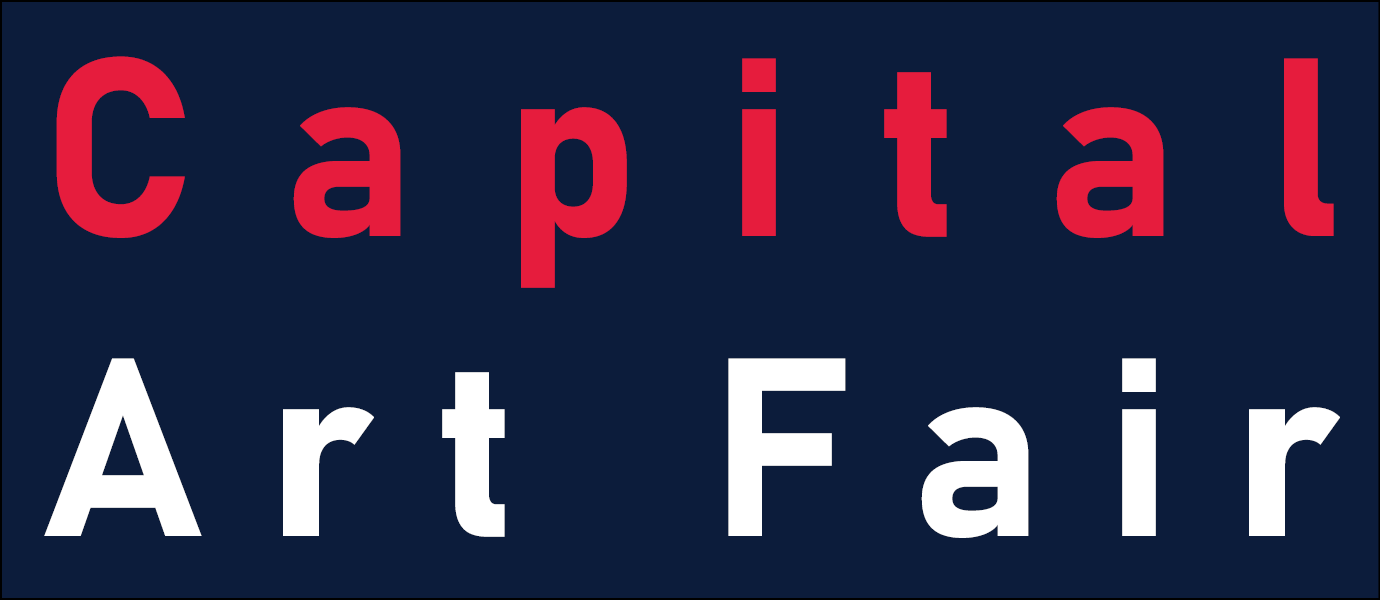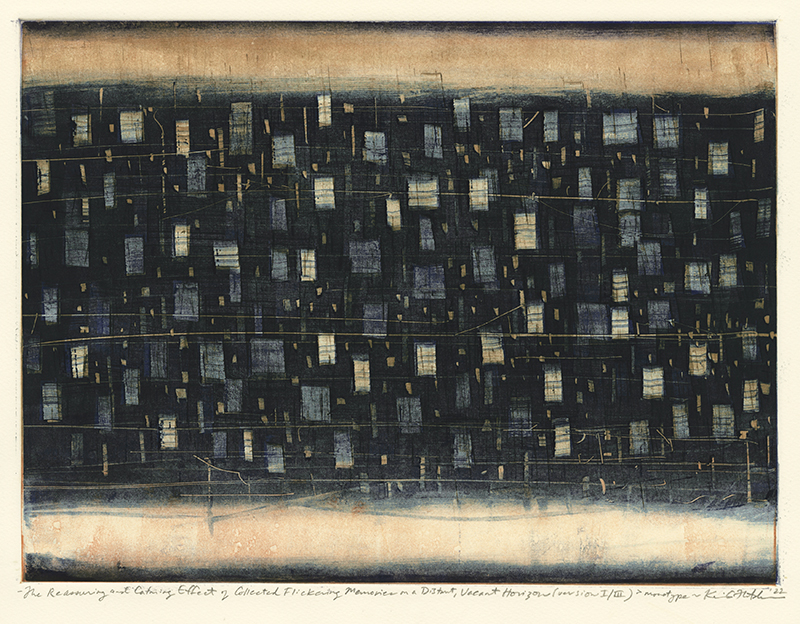The Reassuring and Calming Effect of Collected Flickering Memories on a Distant, Vacant Horizon is a three-color monotype created in 2022 by American artist Kevin Fletcher. It is pencil signed, dated, titled and inscribed (version I/III) monotype. The Reassuring and Calming Effect of Collected Flickering Memories on a Distant, Vacant Horizon was printed by the artist in three passes with the ink worked reductively. This is a unique print on Somerset Natural Rag wove paper and the image measures 11-7/8 x 15-3/4 inches.
In a candid conversation about his work, Kevin Fletcher noted that the horizontal marks within his imagery in The Reassuring and Calming Effect of Collected Flickering Memories on a Distant, Vacant Horizon were created by the edge of a roller. Fletcher described this image as “rolling text on scrolls, the movement traversing the space” and that the imagery recalls to him “the notes of a player piano roll.” His muted palette presents a “rainy, hazy, late-in-day” atmosphere.
Kevin Fletcher,
painter, printmaker, teacher, collector, and curator, was born in Cincinnati,
Ohio on May 7, 1956. He received his BFA in printmaking and graphic design from
Miami University in Oxford, Ohio in 1978 and, the following year, he attended
Northern Illinois University for graduate study in printmaking and art history.
In 1981, Fletcher earned his MFA in printmaking from Syracuse University. In
the early 1980s, he worked for six months at Grafica Uno in Milano, Italy. In
addition to his art career, Fletcher taught drawing, printmaking, watercolor,
history of printmaking, and western art history courses at the Santa Rosa
Junior College in Northern California for thirty years. He was the Visiting
Studio Artist at Pennsylvania School for the Arts, California State -
Fullerton, Shasta College, Pacific Northwest College of Art, Seattle
Printmaking Collective, and San Jose State University.
Fletcher has had at least twenty solo exhibitions and he has been included in
numerous national and international group exhibitions. He curated a number of
exhibitions at the Santa Rosa Junior College during his tenure there. Fletcher
was awarded First Prize in Printmaking from the Berkeley Art Center's Annual
National Exhibition (2007), a First Award from the Greater Midwest
International Print Exhibition XIV at Central Missouri State University (1999),
Monotype Award from the Pacific Prints Annual at the Palo Alto Cultural
Center (1992), First Prize in Printmaking from the Berkeley Art Center's Annual
National Exhibition (1990), and First Prize from the Fourth National Print
Exhibition at the Westwood Center for the Arts in Los Angeles (1981).
Kevin Fletcher's work is represented in the collections of the Royal Museum of
Fine Arts in Antwerp, Belgium; the Belgian National Print Archive, Brussels; the
Cedar Rapids Museum of Art, Iowa; the Cincinnati Art Museum, Ohio; the
Cleveland Museum of Art, Ohio; the Hunterian, University of Glasgow; the Frans
Masereel Centrum, Kasterlee, Belgium; the Miami University Art Museum, Oxford,
Ohio; the City of Portland and the Portland Art Museum, Oregon; the Memorial
Art Gallery, University of Rochester, New York; the Robert F. Agrella Art
Gallery, Santa Rosa Junior College; the Shasta College Art Department,
California; the Jundt Museum at Gonzaga University, Spokane; the Syracuse
University Art Museum, New York; the Library of Congress, Washington, D.C.; the
University of Wisconsin at Waukesha; and the Martin von Wagner Museum at the
University of Wurzburg, Germany.
Says Fletcher of his monotype work:
"I have [been] making these unique prints since 1985 but worked in a
painterly additive manner until 1997 when I came around to working reductively
(Black Manner) from a rolled-up solid black ink, with tools at hand. This was
at a demonstration in Pennsylvania. It sort of surprised me as discoveries do
at times, and I soon began to layer the marks to suggest deeper space. The
tools themselves suggested an architectural solution to the image, though I had
already been gravitating toward this in painting. The urban over the pastoral.
I have taught art history in California and in London so I am acquainted with a
good deal of referential touch stones, if you will. I also collect prints but I
have no aid to my composing an image when working, so if Piranesi, Canaletto,
Goya, or Brangwyn might be suggested, it is only that the drama occurring in my
action / reaction, direct making of the image found this a way of solving the
pictorial "chess match." I have little in mind at the outset,
turning the Plexiglas as I work in my removal and re-instatement of the ink. I
try to keep my vision open (unlocked) and not "wish" an image into
being. It often comes obliquely into view.
"There are sometimes cinematic references and a kind of eddying back upon my own black and white photos from travel, but this is often a subconscious, vague element in my thought process. It is really essential that I can gradually see the whole image come into view, almost like the darkroom development, so the speed of my mark making remains in cadence and does not resort to petty affectations, related to a specific location or cause. (Certainly the 'play books' of the Abstract Expressionist painters Kline, Hoffman, and de Kooning, are dear to me, too!) The great advantage to doing monotype is its relative speed compared with other print technologies, so results can build a momentum in a short time. Remaining ink on the matrix may provide a further direction or tangential suggestion. The layering of added and removed areas of ink, made with sundry commonplace tools allows a kind of reading of reality despite the mere theatrics of direct execution. Little is finessed or the image begins to lose its conviction to its guiding cause of a balanced discovery. It is a happy balance between print and drawing methods and those of the painter. If my work appears a little sentimental or nostalgic, it isn't anything but a connection to gradually surfacing memories or hopeful expectations that infuse results."



